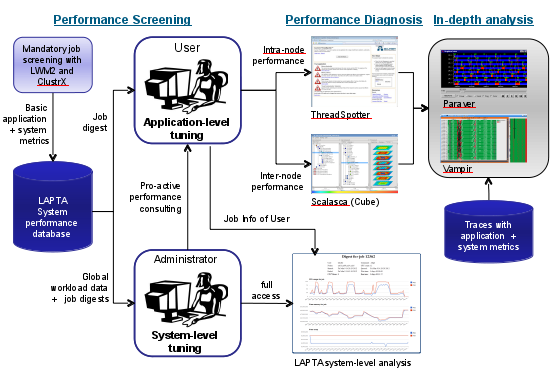Performance-Analysis Workflow
The indented usage and application of the HOPSA performance tools is specified by the HOPSA performance-analysis workflow (see below). It consists of three basic steps. During the first step (“Performance Screening”), we identify all those applications running on the system that may suffer from inefficiencies. This is done via system-wide job screening supported by a lightweight measurement module (LWM2) dynamically linked to every executable. The screening output identifies potential problem areas such as communication, memory, or file I/O, and issues recommendations on which diagnostic tools can be used to explore the issue further in a second step (“Performance Diagnosis”). If a more simple, profile-oriented static performance overview is not enough to pin-point the problem, a more detailed, trace-based, dynamic performance analysis can be performed in a third step (“In-depth analysis”). Available application performance analysis tools include Paraver/Dimemas, Scalasca, ThreadSpotter, and Vampir. The data collected by LWM2 is also fed into the Clustrx.Watch hierarchical cluster monitoring system which combines it with system and hardware data and forwards it to the LAPTA cluster monitoring and analysis system for further analysis by system administrators.
In general, the workflow successively narrows the analysis focus and increases the level of detail at which performance data are collected. At the same time, the measurement configuration is optimised to keep intrusion low and limit the amount of data that needs to be stored. To distinguish between system and application-related performance problems, Paraver and Vampir allow also system-level data to be retrieved and displayed. The system administrator, in contrast, has access to global performance data. He can use this data to identify potential system performance bottlenecks and to optimise the system configuration based on current workload needs. In addition, the administrator can identify applications that continuously underperform and proactively offer performance-consulting services to the effected users. In this way, it facilitates reducing the unnecessary waste of expensive system resources.



